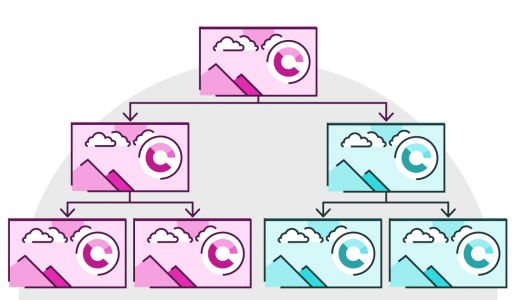Too many self-styled experts don’t clearly recognise that there are many different types of presentations. What works in the ballroom may not work in the meeting room.
By failing to recognise the many ways in which presentations are different – and need to be different – we end up with over-arching presentation theories and approaches that don’t always work, and a confused public attempting to style their intimate management presentations on the latest gadget launches from San Francisco. One size does not fit all.
Types of Presentations: Presentation objectives
Selling vs. teaching
Some types of presentations aim to sell something – a product, an idea, or an ambition. Others aim to teach – a theory, a concept, or even a skill. There can be overlap of course – sales presentations can teach prospects that their current approach is wrong; teaching presentations often need to sell the value of the knowledge imparted before learners will engage. So – it’s a continuum – but fundamentally sales presentations aim to do different things than training presentations – and so should often end up taking a different form.
Telling vs. discovering
Not every presentation is exclusively about what the presenter tells the audience. Sometimes (in seminar rooms or the classroom, or early in a sales cycle) the presenter also wants to discover what the audience thinks too. A presentation designed exclusively for one-way information flow will look different from a presentation that makes space for questions (which, after all, reveal what the audience is thinking about) and discussion. Not every presentation is best-served by asking the audience to passively absorb information for 20 minutes or more.
Types of Presentations: Presentation setting
Ballroom presentations vs. meeting room presentations
Andrew Abela, author of Advanced Presentations by Design, understands that not all types of presentations should be designed in the same way, and sets out the distinction:
‘Ballroom style presentations are what most typical PowerPoint presentations are trying to be: colourful, vibrant, attention-grabbing, and (sometimes) noisy. They typically take place in a large, dark room – such as a hotel ballroom. Conference Room style presentations are more understated… they are more suited to your average corporate conference room.’ (p. 92)
He goes on to point out that:
‘Although most presentations right now are delivered in ballroom style (but badly), relatively few occasions actually call for ballroom style, because this style of presentation is really only appropriate when you have a large audience (say one hundred or more people) whom you are trying to inform or entertain. If you are presenting to a smaller group and/or your goal is to persuade the group in some way – which would seem to be the more common occasion for a presentation – then you should use a conference room style presentation.’ (p. 113)
A lot of the discussion about what makes an effective presentation is modelled on speakers who excelled in a ‘ballroom’ setting – at product launches, keynote addresses, or even at TED. But that isn’t the norm – most presentations are delivered in meeting rooms, or even using a laptop or tablet on a table in a coffee shop. Best practice for one presentation type isn’t necessarily best practice for another.
Face-to-face presentations vs. online presentations
Most things that are written about presentation design concern face-to-face presentations. Yet in these days of reduced travel budgets and webinars for marketing – not every presentation happens in-person.
When presenting online, the rules are different. Why? Because the audience can’t (typically) see the presenter (or if they can, the fidelity is limited), and the presenter can’t (typically) see the audience. That’s hugely significant.
Presentation design rules for face-to-face presentations aren’t the same as for online presentations. Leave a static slide on screen for three minutes in a face-to-face talk, and at least the audience can watch the presenter. Do the same on a webinar and the audience will start writing emails instead. Yet many people offering advice on presentation design are silent on this. To find out more about how to present online effectively, watch our video presentation.
Live presentations vs. on-demand presentations
Not every presentation is experienced live. Platforms such as SlideShare, BrightTALK, or even Vimeo and YouTube allow presentations to be recorded and watched in an asynchronous fashion (i.e. later). On-demand presentations can be perfect for situations where scheduling time in busy diaries is challenging.
Should on-demand presentations be the same as live presentations, but just recorded? We don’t think so. It’s like writing for the web – people are more likely to be in a hurry, and attention levels are shorter. Not something some presentation experts even ever mention.
Single-use vs. multiple use
Some presentations are created from scratch for a single one-off use – a conference, a pitch, or an investor meeting – for example. Other types of presentations – corporate sales presentations or credential presentations for example – are created to be used in multiple settings, with a variety of audiences, and by presenters who may vary in terms of knowledge or skill.
Of course, the ideal situation may be one where each presentation is created from scratch, perfectly targeted to the situation. But that’s not always realistic, and it isn’t always even desirable. When a company wants to retain tight control of messaging and process, a standard deck is often provided for sales people to learn and deliver. In this situation, both messaging and visuals may need to reflect the myriad of situations the presentation will be used in. Not something that theorists talk about – but something that they ought to talk about, because it’s so common.
Interactive vs. linear
Some presentations are designed to be delivered in a linear way – no deviation, no surprises, no jumping around, and no responding to audience questions or comments, except perhaps very briefly at the end. Other presentations work better if they are more interactive, leave more space to respond to audience comments and questions, and may not have fixed content. This type of presentation is more like a visual conversation than a regular presentation.
Not every presentation should be linear, and interactivity works well in all sorts of settings and for all sorts of reasons. Yet this presentation type is often ignored by those who think only of keynotes and ballroom presentations when they write about presentations.
Presentation vs. speech vs. slides
It’s worth pointing out that not every so-called presentation is really a presentation at all. I would argue that a presentation requires a presenter and slides (or other visual aids).
A presenter without visual aids is simply giving a speech. A set of slides without a presenter – sent by email, or put up on SlideShare – is just a set of slides. It doesn’t help when e.g. SlideShare describes itself as ‘the world’s largest community for sharing presentations’ when it’s primarily for sharing slides.
Stay vigilant! If you have no visual aids, or no presenter, you have no presentation.
Different settings, different visual aids
There’s a well-known saying that to a man with a hammer, every problem looks like a nail. Too many presentation experts, authors, and theorists just use a single approach.
Too much of the discussion about presentations is about ballroom presentations – using static slides containing a single photograph each and a single line of text. This approach is reasonable for keynote speeches – but can be wholly unsuitable for many others. This type of presentation doesn’t use enough animation for online use, doesn’t provide enough visual support or detail for seminar-room or classroom use, and the visuals don’t do enough ‘heavy lifting’ for use by less confident or knowledgeable presenters.
There are different types of presentations, and different types of visual aid. Companies may need more than one tool in their arsenal. Use the right tool for the job. To do that, you first need to understand your presentation objectives and setting, and only then think about your slides.
Leave a comment




